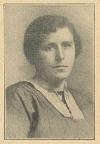Mary Barbour
Their names will be remembered for evermore
During the war the groundswell of political activism in Glasgow grew because of housing shortages. Women campaigned for many social improvements, and the galvanising force was Mary Barbour. On 17 November, 1915, thousands of Glaswegians united with her against the profiteering landlords who had driven up rents.
Mrs Barbour and her husband David had moved from Dumbarton to Govan at the turn of the century. While raising two young children, she continued with the political activism that she had begun before the war. She joined groups such as the Scottish Co-operative Women's Guild and Socialist Sunday Schools, and became a member of the Independent Labour Party, in what was to become known as Red Clydeside.
In 1914, as thousands were recruited to work in armaments manufacture or the shipyards, overcrowding took hold. Landlords took advantage of the demand for housing and began pushing up rents.
The newly formed Glasgow Women's Housing Association gave a voice to mothers struggling to survive in the teeming tenements. Mrs Barbour set up the South Govan branch, and was quickly joined by many housewives. She arranged meetings in kitchens and tenement closes, and developed her network of activists. They banded together to oppose evictions, using bells and rattles to quickly mobilise a crowd to drive off the bailiffs. Their refusal to pay the inflated rents was supported by shipyard and factory workers who threatened to strike to support those facing eviction.
On the march with 'Mrs Barbour's Army'
On 17 November, 1915, "Mrs Barbour's Army", as they were nicknamed, marched on the sheriff courts against one landlord's attempt to force 18 evictions - 15 of which involved munitions workers. Although peaceful, the demonstration was barred from entering the building, which overflowed with non-payers and their supporters. With feelings running high, the court called David Lloyd George, the munitions minister, who ordered the tenants to be released and the cases dropped. Cheers went up inside the court and out, where the crowd numbered 20,000.
The Rent Restriction Act followed, fixing rents across the UK at their pre-war level while the conflict lasted. Her name now synonymous with the rent strikes, Mrs Barbour continued her political life.
Recognition in Office
Mrs Barbour became one of Glasgow's first two female Labour Party councillors in 1920, elected alongside another three women representing the so-called Moderate group. She was later Glasgow's first woman Bailie. Women's and children's health were her interests, and she helped to increase child clinic provision. Her own experience, of having lost her first son aged 10 months, in 1897, likely set her off on a journey that would see personal hardship make for a greater good. She died aged 83 in 1958.
View original referenced text here:Mary Barbour referenced text (PDF, 95 KB)(opens new window)
Images :
- Mary Barbour in a picture used for her election campaign literature in 1920. Credit: Glasgow Caledonian University Archives - The Gallacher Memorial Trust.
- Protesters with placards bearing slogans that compare the landlords to the ruling class of wartime Germany. Credit: @CSG CIC Glasgow Museums Collection.
- Mary Barbour in her robes and chain of office, around 1924, when she became both Glasgow's first woman Bailie, and a magistrate. She continued working for better health and welfare provision even after retiring from the council in 1931. Credit: Glasgow Caledonian University Archives - The Gallacher Memorial Library Collection.








